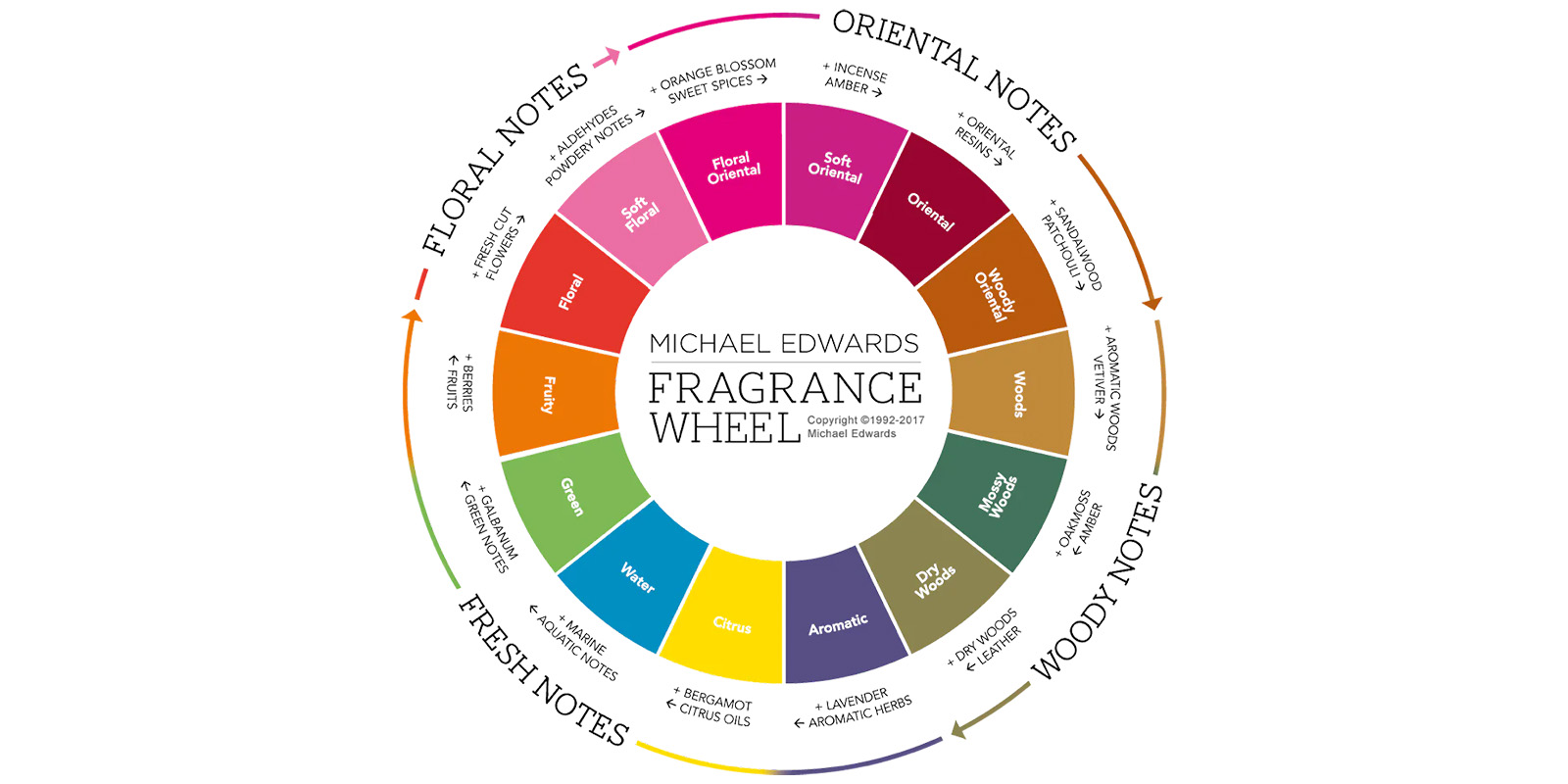Understanding Fragrance: A Valuable Skill
The ability to discern and appreciate various fragrances is a learned skill and one that anybody can practice to enrich their sensory skills or better comprehend fragrances. Although not strictly mathematical, as describing fragrance still requires a bit of imagination, tools like Michael Edwards’ Fragrance Wheel prove to be invaluable. While scent can be subjective, there are usually general ideas or themes that one can pick up on. Categorizing and naming fragrance components helps to make associations between different fragrances and understand their origin and character with greater context. The ability to discern between various fragrances can grow stronger over time with practice and deepen one’s relationship to the sensory world overall.
The Fragrance Wheel
The fragrance wheel was developed by perfumer Michael Edwards in 1983. Much like a color wheel, it groups categories together in a way that allows for overlap and gradual variances. Fragrance families or olfactive groups are based on aromatic characteristics commonly found across all fragrances. The wheel is useful in that it provides a visual representation of the olfactive spectrum.
The Fragrance Wheel uses four major scent categories: floral, oriental, woody, and fresh. Each category then has subgroups that further define these characteristics based on aromatic variances. These include floral oriental, soft oriental, woody oriental, mossy woods, dry woods, aromatic, citrus, water, green, and fruity.

The Fragrance Families
Floral
Floral fragrances encompass a beautiful bouquet of floral style scents, from delicate rose to exotic jasmine, and sweet strong tuberose that evoke elegance and femininity. Floral fragrances with powdery notes can referred to as soft floral, while sweet, spicier fragrances with notes like orange blossom falling under the subcategory floral oriental.
Find verdant floral in Ginger Flower, floral citrus in Zuri and Zesty White Tea, and floral oriental in Spice Trader.
Oriental
As floral notes move into oriental, there is a noticeable depth and complexity that appears in this style. Indulgent and luxurious, the oriental family includes notes of amber and incense in soft oriental, resins, and woodier notes like sandalwood and patchouli in woody oriental.
Explore Amber Grand, Thé Vert Oriental, and Spice Trader in Oriental scent styles.
Woody
Scent notes described as woody are often very important in the overall composition of a fragrance, as these stronger base notes help build the foundation for the scent and allow the notes to work together seamlessly. Aromatic woods include the root Vetiver, while mossy woods include notes of oakmoss. Dry woods include cedarwood and leather. Earthy, warm and sophisticated, woody notes play a prominent role in popular scent compositions.
Smell Cedar Mood, Havana, Sandalwood Gold, and Saffron Suede as some of our favorite woody styles.
Fresh
Refreshing and clean, fresh notes offer a lightness that is found within various subcategories – often in citrus like bergamot and lemon, aquatic styles in marine notes, fruity in notes like berries, green in grass and botanical notes, and aromatic or herbal notes including lavender, mint and rosemary. Many fresh fragrances reiterate invigorating experiences in nature, like fresh morning mists or a walk along the seashore.
Discover fresh styles in Illuminate, White Tea Thyme, Sunkissed, and Iron Bark.
Using the Fragrance Wheel
View the wheel as you’re smelling fragrances to build the associations and start identifying fragrance families. Let the wheel be your guide and pinpoint the prominent notes in a fragrance composition, tracing their placement on the wheel. By understanding the primary olfactive families and their subgroups, you can decipher the composition of a scent and appreciate its nuanced character.
In the end, it’s not just about smelling the fragrance; it’s about experiencing the emotions, memories, and dreams it evokes. Just as a symphony transcends the individual music notes on a page, a fragrance exceeds the mere combination of its notes.
Explore Air Aroma’s range of fragrances to discover unique, elevated scent compositions.

